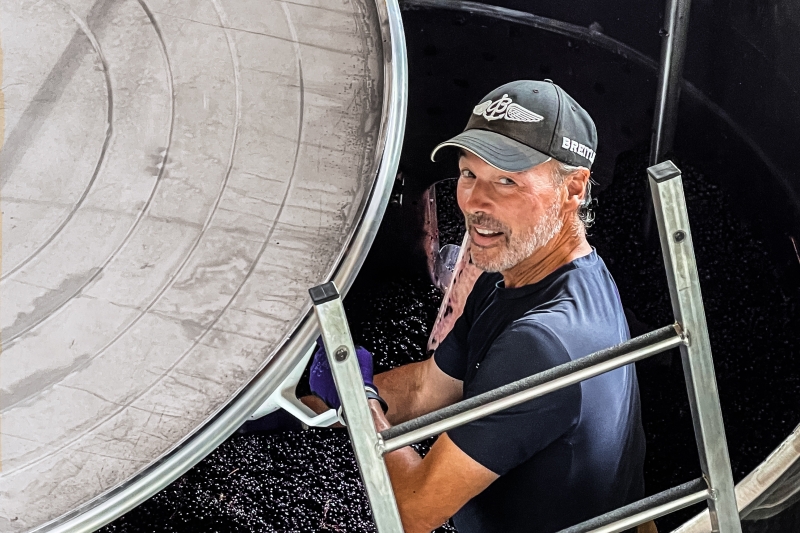The Art Of: Crushing the Grape Enrico de Alessandrini ’84, P’23 is the owner of award-winning Sassaia Winery.
“We are becoming ‘glocal’ by collaborating with winemakers from France, California, Virginia and Italy in a quest to revive local businesses by making wine with both indigenous and globally known varieties.”
~ Enrico “Rick” de Alessandrini ’84, P’23
Enrico “Rick” de Alessandrini ’84, P’23, owner of Sassaia Winery (sassaia.com), has discovered that producing an award-winning wine involves ancient tradition, modern technology, some luck and a lot of science.
As the son of Italian immigrants, de Alessandrini grew up in both Italy and the U.S. due to his father’s role as the Italian vice consul in Norfolk. “At first, I felt out of place. My father instilled in me the importance of evolving over time like a great wine by having a deep appreciation for your roots and culture. In essence, what my father taught me and what W&L reinforced, is to understand and embrace all traditions and at the same time help ensure their intentions remain relevant. This philosophy drives my winemaking style which respects tradition andembraces innovation.”
When de Alessandrini transitioned into his second career in 2012, he had to brush up on organic chemistry, a pre- requisite for admission to the University of California Davis’ Winemaking Certificate Program, which he completed at the top of his class in March 2022. For the economics major and former commodities hedge fund manager, tackling organic chemistry as he approached 60 was no small challenge.
“I had a lot more hair before I took the course,” he laughed.
He is now on a mission to share his acquired knowledge by making Sassaia a collaborative learning center where vintners can learn best practices implemented around the world. “We are becoming ‘glocal’ by collaborating with winemakers from France, California, Virginia and Italy in a quest to revive local businesses by making wine with both indigenous and globally known varieties,” he explained.
Ten years ago, de Alessandrini and his wife, Ellen P’23, past chair of the Williams School Advisory Board, began renovating his family’s ancestral home in the Piedmont region of Italy, purchasing adjoining hectares and growing Cortese (Gavi) grapes for resale in the secondary market. “As central banks around the world drove yields to zero, it was like owning a bond with a decent yield,” he said.
Early on, he reached out to Pierre Naigeon in Gevrey Chambertin Burgundy, also known for its single varietals. In 2017, the two began collaborating to develop Sassaia’s prize-winning Timorasso, a white varietal native to Piedmont. The low residual sugar, low sulfitewine is made the old-school way — handpicked and barrel fermented with the natural yeast from those grapes.
He employs the latest technology to time optimal picking and viability of the natural yeast. “This is where technology blends with five generations of experience. We can grow and vinify with a minimalist and sustainable approach,” he said.
De Alessandrini’s 2019 Derthona Timorasso Platinum earned second place from Germany’s prestigious wine journal Falstaff Magazine.
The Alchemy of Yeast
The most common method of making wine is to inoculate the must (freshly crushed grapes) with yeast and let the mixture ferment. In an effort to tease out some native elements, Sassaia uses indigenous yeast in a process through which three natural yeasts work in tandem to produce a more complex wine at lower levels of alcohol. The first two die out at around 5% alcohol, after which Saccharomyces takes over and completes the fermentation. This slower method of producing wine at a lower temperature requires rigid hygiene standards, but it results in a very delicate product with a distinctive flavor profile. It is a tricky business. “With indigenous yeast, you get something truly authentic, but there are some risk and time management issues. It is not good for bulk production,” de Alessandrini explained.
The 2022 harvest was started between 10 days and two weeks earlier than usual due to reduced rainfall and higher than average heat. The current climate cycle is seeing a rebirth of certain indigenous varietals like Timorasso that thrive with less rain. Timorasso is also experiencing a rebirth due to its natural high acidity which lends itself to long term aging and explains why it is being identified as “The White Barolo”.
The Rockbridge Connection
Michael and Cierra Weatherly, owners of the Ecco Adesso Vineyard in Fairfield, have visited Sassaia multiple times as one of the collaborative network of vintners from around the world who convene in Piedmont to learn from one another. Sassaia’s Timorasso and other wines are available in Ecco Adesso’s tasting room, Southern Inn, Old Lex Mercantile and Main Street Purveyors. de Alessandrini hopes his vineyard’s success will help the stimulate the local economies. “It’s truly the most enjoyable thing I’ve done to this day.”
 Enrico “Rick” de Alessandrini ’84, P’23 (Photo by Ellen de Alessandrini P’23)
Enrico “Rick” de Alessandrini ’84, P’23 (Photo by Ellen de Alessandrini P’23)
You must be logged in to post a comment.